#berenice vega
Text
RWBY Spanish dub
Protagonists: Team JNPR
Jaune Arc/The Rusted Knight
EN: Miles Luna
LA: Óscar Flores
Nora Valkyrie
EN: Samantha Ireland
LA: Analiz Sánchez
Nora Valkyrie (young)
EN: Kristen McGuire
LA: Regina Carrillo
Pyrrha Nikos
EN: Jen Brown
LA: Berenice Vega
Lie Ren
EN: Monty Oum (Volumes 1-2)/Neath Oum (Volumes 3-)
LA: Alan Fernando Velázquez
Lie Ren (young)
EN: Apphia Yu
LA: Zoe Mora
Regina Tiscareño was the previous choice for the role of Nora.
Sergio Gutiérrez Coto was the previous choice for the role of Ren.
Gaby Cárdenas was the previous choice for the role of young Ren.
#rwby#rwby spanish dub#team jnpr#jaune arc#the rusted knight#miles luna#óscar flores#nora valkyrie#samantha ireland#analiz sánchez#kristen mcguire#regina carrillo#pyrrha nikos#jen brown#berenice vega#lie ren#monty oum#neath oum#alan fernando velázquez#apphia yu#zoe mora#arkos#renora
8 notes
·
View notes
Note
For the ask game, please! Lenore, Annabel Lee, and the whole cast actually being brought back to life... but in the modern world.
I can't limit myself to five for this one:
1. Through complicated shenanigans the cast teamed up, took over the school, beat up the deans, and all got resurrected. No one is sure if they ended up in the modern world as one last prank from the deans or if it always would have been like that. Some of the cast miss their families but frankly Lenore, Annabel, and a few others are relieved.
2. The group gets dumped in an American city with modern clothing, identification, and bank cards with a hundred thousand dollars. Unfortunately they have no modern knowledge and don't know how to use the cards. Luckily their odd behavior attracts the attention of Theo, Lenore's brother (to their mutual delight). He passed previously and came back to life a few years ago. He's currently working at a museum and applying his very good historical knowledge. Theo confirms that the deans gave him a tutorial on modern life but couldn't be bothered to help the rebels. He helps everyone settle in.
3. Annabel is living her absolute best life in a world with far more opportunities for women. She enrolls in business school, then starts her own company. Currently she's considered going into politics because she's bored at how easy it is for her to make money.
4. Lenore is a kept woman living in Annabel's enormous mansion and a disability rights activist. She runs marathons as a hobby. She's a bit nervous about Annabel going into politics for fear she will be a little too good (or should I say evil?) at it. The two of them are so obnoxiously lovey-dovey that their friends wish they would go back to pretending to be enemies.
5. At school, Morella developed a lot more confidence, started experimenting with self-expression, and went through a goth and punk phase in rapid succession before deciding she was actually just a preppy lesbian.
6. Duke and Pluto have their own magic show together in Las Vegas. Duke specializes in escape tricks. Pluto trains tigers.
7. Eulalie and Pluto got married and look after a hoard of foster children together.
8. Ada decided to focus on learning to live alone and like herself after her bad experiences with Prospero. But she still has a fascination with romance novels and opened her own bridal gown shop, secretly dreaming of falling in love someday.
9. Prospero became a neurosurgeon. He cares about very little outside his career, which he's very good at.
10. Berenice joined a band and works part-time as a waitress. She crashed at Eulalie's place repeatedly during hard time, but she's finally starting to see success.
11. Montressor only lasted a week before he got thrown in jail for running scams.
12. The whole group meets up once a year for dinner to talk about the old days. And for Annabel to brag about how happy she is with Lenore.
32 notes
·
View notes
Note
Most wanted female?
michelle yeoh, burcu ozberk, brooke shields, angela basset, monica bellucci, anne hathaway, wunmi mosaku, anya taylor joy, may calamawy, aishwarya rai bachchan, brianne howey, jessica alba, sarah shahi, gabrielle union, deepika padukone, shu qi, janelle monae, veronica ngo, zhang ziyi, min hyorin, sonam kapoor, gemma chan, constance wu, lupita nyong’o, aubrey plaza, berenice marlohe, diane guerrero, hannah waddingham, paz vega, greta lee, nicole kidman, aditi rao hydari !!
3 notes
·
View notes
Text
January’s Night Sky Notes: Connecting the ‘Dots’ with Asterisms
by Kat Troche of the Astronomical Society of the Pacific
In our December Night Sky Notes, we mentioned that the Orion constellation has a distinct hourglass shape that makes it easy to spot in the night sky. But what if we told you that this is not the complete constellation, but rather, an asterism?
An asterism is a pattern of stars in the night sky, forming shapes that make picking out constellations easy. Cultures throughout history have created these patterns as part of storytelling, honoring ancestors, and timekeeping. Orion’s hourglass is just one of many examples of this, but did you know Orion’s brightest knee is part of another asterism that spans six constellations, weaving together the Winter night sky? Many asterisms feature bright stars that are easily visible to the naked eye. Identify these key stars, and then connect the dots to reveal the shape.
Asterisms Through the Seasons
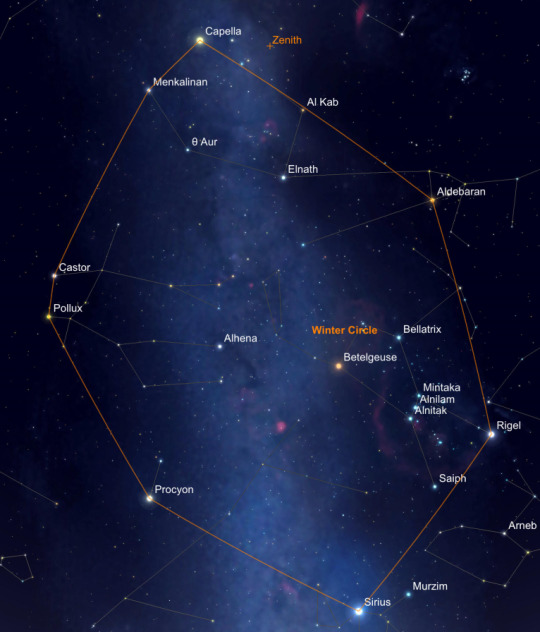
Stars that make up the Winter Circle, as seen on January 1, 2024
Sky Safari
Try looking for these asterisms this season and beyond:
Winter Circle – this asterism, also known as the Winter Hexagon, makes up a large portion of the Winter sky using stars Rigel, Aldebaran, Capella, Pollux, Procyon, and Sirius as its points. Similarly, the Winter Triangle can be found using Procyon, Sirius, and Betelgeuse as points. Orion’s Belt is also considered an asterism.
Diamond of Virgo – this springtime asterism consists of the following stars: Arcturus, in the constellation Boötes; Cor Caroli, in Canes Venatici; Denebola in Leo, and Spica in Virgo. Sparkling at the center of this diamond is the bright cluster Coma Berenices, or Bernice's Hair – an ancient asterism turned constellation!
Summer Triangle – as the nights warm up, the Summer Triangle dominates the heavens. Comprising the bright stars Vega in Lyra, Deneb in Cygnus, and Altair in Aquila, this prominent asterism is the inspiration behind the cultural festival Tanabata. Also found is Cygnus the Swan, which makes up the Northern Cross asterism.
Great Square of Pegasus – by Autumn, the Great Square of Pegasus can be seen. This square-shaped asterism takes up a large portion of the sky, and consists of the stars: Scheat, Alpheratz, Markab and Algenib.
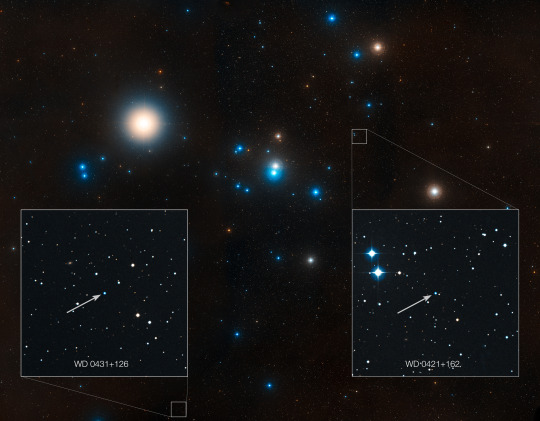
This image shows the region around the Hyades star cluster, the nearest open cluster to us. The Hyades cluster is very well-studied due to its location, but previous searches for planets have produced only one. A new study led by Jay Farihi of the University of Cambridge, UK, has now found the atmospheres of two burnt-out stars in this cluster — known as white dwarfs — to be “polluted” by rocky debris circling the star. Inset, the locations of these white dwarf stars are indicated — stars known as WD 0421+162, and WD 0431+126.
NASA, ESA, STScI, and Z. Levay (STScI)
Tracing these outlines can guide you to objects like galaxies and star clusters. The Hyades, for example, is an open star cluster in the Taurus constellation with evidence of rocky planetary debris. In 2013, Hubble Space Telescope’s Cosmic Origins Spectrograph was responsible for breaking down light into individual components. This observation detected low levels of carbon and silicon – a major chemical for planetary bodies. The Hyades can be found just outside the Winter Circle and is a favorite of both amateur and professional astronomers alike.
How to Spot Asterisms
Use Star Maps and Star Apps – Using star maps or stargazing apps can help familiarize yourself with the constellations and asterisms of the night sky.
Get Familiar with Constellations – Learning the major constellations and their broader shapes visible each season will make spotting asterisms easier.
Use Celestial Landmarks –Orient yourself by using bright stars, or recognizable constellations. This will help you navigate the night sky and pinpoint specific asterisms. Vega in the Lyra constellation is a great example of this.
Learn more about how to stay warm while observing this Winter with our upcoming mid-month article on the Night Sky Network page through NASA's website!
0 notes
Text
January’s Night Sky Notes: Connecting the ‘Dots’ with Asterisms - Technology Org
New Post has been published on https://thedigitalinsider.com/januarys-night-sky-notes-connecting-the-dots-with-asterisms-technology-org/
January’s Night Sky Notes: Connecting the ‘Dots’ with Asterisms - Technology Org
In NASA’s December Night Sky Notes, authors mentioned that the Orion constellation has a distinct hourglass shape that makes it easy to spot in the night sky. But what if we told you that this is not the complete constellation, but rather, an asterism?
Stars that make up the Winter Circle, as seen on January 1, 2024, Sky Safari
An asterism is a pattern of stars in the night sky, forming shapes that make picking out constellations easy. Throughout history, cultures have created these patterns as part of storytelling, honoring ancestors, and timekeeping.
Orion’s hourglass is just one of many examples of this, but did you know Orion’s brightest knee is part of another asterism that spans six constellations, weaving together the Winter night sky? Many asterisms feature bright stars that are easily visible to the naked eye. Identify these key stars, and then connect the dots to reveal the shape.
This image shows the region around the Hyades star cluster, the nearest open cluster to us. The Hyades cluster is very well-studied due to its location, but previous searches for planets have produced only one. A new study led by Jay Farihi of the University of Cambridge, UK, has now found the atmospheres of two burnt-out stars in this cluster — known as white dwarfs — to be “polluted” by rocky debris circling the star. Inset, the locations of these white dwarf stars are indicated — stars known as WD 0421+162, and WD 0431+126. Image credit: NASA, ESA, STScI, and Z. Levay (STScI)
Try looking for these asterisms this season and beyond:
Winter Circle – this asterism, also known as the Winter Hexagon, makes up a large portion of the Winter sky using stars Rigel, Aldebaran, Capella, Pollux, Procyon, and Sirius as its points. Similarly, the Winter Triangle can be found using Procyon, Sirius, and Betelgeuse as points. Orion’s Belt is also considered an asterism.
Diamond of Virgo – this springtime asterism consists of the following stars: Arcturus, in the constellation Boötes; Cor Caroli, in Canes Venatici; Denebola in Leo, and Spica in Virgo. Sparkling at the center of this diamond is the bright cluster Coma Berenices, or Bernice’s Hair – an ancient asterism turned constellation!
Summer Triangle – as the nights warm up, the Summer Triangle dominates the heavens. Comprising the bright stars Vega in Lyra, Deneb in Cygnus, and Altair in Aquila, this prominent asterism is the inspiration behind the cultural festival Tanabata. Also found is Cygnus the Swan, which makes up the Northern Cross asterism.
Great Square of Pegasus – by Autumn, the Great Square of Pegasus can be seen. This square-shaped asterism takes up a large portion of the sky, and consists of the stars: Scheat, Alpheratz, Markab and Algenib.
Tracing these outlines can guide you to objects like galaxies and star clusters. The Hyades, for example, is an open star cluster in the Taurus constellation with evidence of rocky planetary debris. In 2013, Hubble Space Telescope’s Cosmic Origins Spectrograph broke down light into individual components. This observation detected low levels of carbon and silicon – a major chemical for planetary bodies. The Hyades can be found just outside the Winter Circle and is a favorite of both amateur and professional astronomers alike.
Use Star Maps and Star Apps – Using star maps or stargazing apps can help familiarize yourself with the constellations and asterisms of the night sky.
Get Familiar with Constellations – Learning the major constellations and their broader shapes visible each season will make spotting asterisms easier.
Use Celestial Landmarks –Orient yourself by using bright stars, or recognizable constellations. This will help you navigate the night sky and pinpoint specific asterisms. Vega in the Lyra constellation is a great example of this.
Source: National Aeronautics and Space Administration
#2024#Administration#aeronautics#altair#apps#Astronomy#Astronomy news#carbon#celestial objects#chemical#cluster#clusters#coma#Coma Berenices#debris#december#dwarf stars#easy#ESA#eye#Featured Space news#galaxies#History#Hubble#Hubble Space Telescope#inset#Inspiration#it#knee#learning
0 notes
Text
Todo listo para el Premio Estatal del Deporte 2022

Votación el 18 de octubre en el Salón 25 de Marzo de Palacio de Gobierno a las 10:00 horas; están nominados 22 deportistas y 5 entrenadores a este reconocimiento
Este martes 18 de octubre se conocerá al deportista y entrenador ganador de la trigésima primera edición de la Elección del Premio Estatal del Deporte, llevándose a cabo la ceremonia de elección en el Salón 25 de Marzo de Palacio de Gobierno a las 10:00 horas.
El Jurado integrado por 10 miembros pertenecientes a asociaciones deportivas, medios de comunicación, directivos, así como ganadores del Premio Estatal del Deporte en ediciones anteriores, serán los encargados de elegir a los ganadores que destaquen por sus logros del 11 de octubre del 2021 al 11 de octubre de 2022.
El Premio Estatal del Deporte apoya, promueve y reconoce anualmente a los atletas y entrenadores más destacados, que desarrollan actividades en beneficio al deporte en el Estado.
Se repartirá entre los ganadores una bolsa de premios de 110 mil pesos; asimismo, se otorgarán medalla alusiva al evento, cheque simbólico y una estatuilla, los cuales serán entregados durante la ceremonia de premiación a realizarse el día 20 de noviembre, en el marco de la conmemoración de la Revolución Mexicana.
Entrenadores Nominados
1. Rubén Martín Arikado González Atletismo
2. Leonardo Juan Avelle Ugarte Atletismo
3. Julio César Rascón Delgado Béisbol
4. Alexis Hibraim Orozco Reza Porras
5. Gabriela Isela Alarcón Gómez Voleibol
Deportistas Nominados
1. Alba Gabriela Amparán Macías Atletismo
2. Saúl Mena Gómez Atletismo
3. Isabella Flores López Ajedrez
4. Mia Fernanda Guzmán García Ajedrez
5. Channel Lucero Ochoa Salinas Básquetbol
6. Emilio Antonio Roa Vega Boxeo
7. Gloria Carolina Fernández Quiñonez Boxeo
8. Marco Ariel Hernández Alvídrez Boxeo
9. Ana Paola Rodríguez Martínez Gimnasia
10. Perla Fernández Hidalgo Handball
11. Diana Rubio Leyva Jiu Jitsu
12. Alejandro Ramos Morales Judo
13. Vanessa Anahí Villegas Barraza Voleibol
14. Jashel Dorado Mendiola Levantamiento de Pesas
15. Blanca Josel Pallares Fierro Levantamiento de Pesas
16. Carlos Aguilar García Natación
17. Rodrigo Montoya Solís Raquetbol
18. Ashley Berenice Salas Santacruz Tiro con Arco
19. María de Lourdes Hernández Delgado Triatlón
20. Almendra Esther Ramírez Flores Ultimate Frisbee
21. Luis David Hernández Baca Voleibol
22. Yessenia Arizbeth Medrano Mendoza WuShu
0 notes
Text
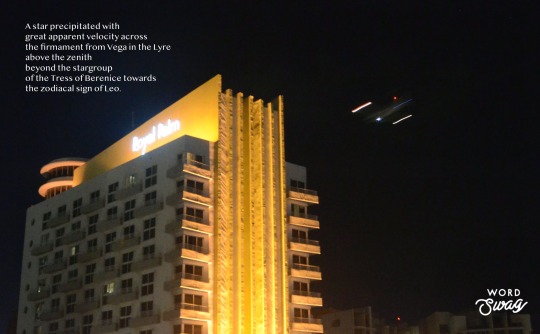
"What celestial sign was by both simultaneously observed?
A star precipitated with great apparent velocity across the firmament from Vega in the Lyre above the zenith beyond the stargroup of the Tress of Berenice towards the zodiacal sign of Leo."
72-73/80
0 notes
Text
Sorry to my American mutuals I know it didn't go well over there, but I LOVE that Spanglish movie. I LOVE IT. Lmao
The mom is amazing and horrible and going through it yk because she'd just lost her job! and she's so much like my mom and like me at times she's the bad guy but is like an amazing villain like: white rich woman. Be afraid.
And then Flor is gooooorgeous bc Paz Vega is a goddess and I see her in my sisters and friends and my mom again sometimes and in me if I'm being kind to myself and then Adam Sandler's character is such an idiot lol and like a "nice guy" but also so sweet and lost I love him he reminds me of a couple of boyfriends I loved. And the grandma!! Ayayay divina adoradísima most beloved. And Berenice is like aaaay🙈💕 my sister at that age to a t. Her kindness her heart... The other kid too, he's the sweetest... and then Christina is ME. She's the worst lmao like to me she's the least beloved character but like everything she does I would've done like so true bestie guilt-trip your mom into having you take that scholarship lmao aaaaaayyy...
I just love that movie. Love it. Amazing movie. Best movie. Aaa no ok but really great movie, beloved even.
#spanglish#fave movies#paz vega#adam sandler#tea leoni#Latinxs in media#representation for me.#representation in media
10 notes
·
View notes
Text
Perspectiva de género en la obra pública, más que una necesidad, es un valor de nuestra sociedad

La secretaria de Desarrollo Urbano y Obras Públicas, Romy Rojas Garrido, afirmó que la obra pública, además de ser una herramienta que fomenta el crecimiento económico, es un gran instrumento para reducir las brechas de desigualdad de género. La funcionaria participó en el Diplomado “Formación para incorporar la Perspectiva de Género en el Diseño, Planeación, Gestión y Ejecución de la Obra Pública en el Estado de Querétaro”, con la ponencia “Diseño de obras públicas con perspectiva de género”. En ese marco, afirmó que la incorporación de la perspectiva de género en la obra pública busca contribuir a la construcción de ciudades más amables y pensadas para cerrar las brechas de género que impiden que hombres y mujeres se desarrollen plenamente a través del goce y disfrute de las ciudades en su lucha por ser incluso más sostenibles.

Destacó que en el Informe Global de Brecha de Género que se presentó en el Foro Económico Mundial en 2018, México ocupaba el lugar 50 de 149 países analizados, lo que se refleja en el diseño y la construcción de espacios poco incluyentes e inseguros que no son “propios de mujeres y para mujeres solas”. Ante estas cifras, Rojas Garrido aseguró que uno de los grandes desafíos para lograr la incorporación de la perspectiva de género en los procesos de obra pública, es su integración desde la planeación, el diseño, la construcción, la administración, la evaluación y el monitoreo. Por ello, la titular de la SDUOP hizo hincapié en la necesidad de fortalecer los procesos de capacitación y sensibilización en perspectiva de género a los actores involucrados; priorizar la mano de obra local que favorezca a las mujeres y sus familias, garantizar su seguridad en las obras públicas, ofreciendo espacios más iluminados, con arquitectura de paisaje y elementos de diseño.

Señaló la importancia de que estos conceptos no estén sujetos a la voluntad de quienes realizan la obra pública, sino que queden establecidos en el reglamento interno de diseño de espacios públicos. Asimismo, mencionó que a pesar de que la participación de las mujeres en el desarrollo de la obra pública y en especial en la industria de la construcción es aún muy baja, las mujeres han ganado terreno. En el caso particular de la SDUOP, su titular aseguró que la plantilla de colaboradores con la que cuenta la dependencia es de 43 por ciento mujeres y 57 por ciento hombres, una correspondencia más equilibrada que la que se manejaba en el pasado, con un mayor número de mujeres incorporadas a una dependencia ocupada históricamente en su mayoría por hombres. Asimismo, destacó las acciones de carácter institucional implementadas al interior de la SDUOP, tales como cursos de sensibilización impartidos a todo el personal y la adopción del Manual de Obras Públicas con Perspectiva de Género, con más de 300 cursos y alrededor de 700 participantes desde 2017, en coordinación con el Instituto Queretano de la Mujer.

Finalmente, Romy Rojas reconoció la ardua labor que realiza Laura Sepúlveda Antuna al frente de las Mujeres Empresarias de la Cámara Mexicana de la Industria de la Construcción (CMIC), ya que logra abrir camino para una mayor equidad en el trabajo entre hombres y mujeres en el ámbito de la construcción, además de que la incorporación de la perspectiva de género en obra pública debe entenderse como un ejercicio constante de capacitación y sensibilización. Por su parte, la directora administrativa de la SDUOP, Liz Berenice Guzmán Flores, detalló las acciones que dentro de la dependencia se realizan para contribuir a que en la obra pública se imprima la perspectiva de género. En el diplomado participaron el presidente y la vicepresidenta del Comité Directivo CMIC, Álvaro Ugalde Ríos y Laura Sepúlveda Antuna. Asimismo, asistieron la directora del Instituto Queretano de la Mujer (IQM), Valeria Guerrero Ángeles; la ex presidenta del Colegio de Ingenieros Civiles Querétaro, Viridiana Nava Rodríguez; la ex presidenta de la CMIC-delegación Querétaro, Alejandra Vega Reyes, así como constructores e invitados especiales en la industria de la construcción.
#QuerétaroTuyo#QroTuyo#Querétaro#Género#Obra#Pública#Sociedad#SDUOP#RomyRojas#Desigualdad#Instrumento#Desarrollo#Ponencia
1 note
·
View note
Video
youtube
Il cielo di maggio 2020
E’ impossibile non associare il mese di maggio alla bellissima stagione primaverile, quando finalmente si ripongono i cappotti negli armadi e ci si può trattenere fuori anche nelle ore serali, senza battere i denti, ad osservare il cielo ad occhio nudo. Alte nel cielo, in direzione Sud, le costellazioni del Leone e della Vergine, tra le più estese dello zodiaco, dominano la volta celeste.
Quest’ultima è un’ampia costellazione zodiacale le cui stelle più luminose disegnano una evidente Y. Gli oggetti celesti più importanti visibili ad occhio nudo che costituiscono tale costellazione, o che si trovano in corrispondenza di essa, sono Alpha Virginis, nota come Spica, la quindicesima stella apparentemente più luminosa del cielo che marca la base della Y. Poi c’è l’Ammasso di Galassie della Vergine che riempie quasi totalmente la parte superiore della Y; questo ricco ammasso contiene almeno 2.500 galassie di diverso tipo, dalle spirali alle ellittiche, e si trova a circa 60 milioni di anni luce da noi.
Sotto la Vergine possiamo riconoscere le costellazioni, di dimensioni decisamente minori, del Corvo e del Cratere. Le stelle più brillanti le troviamo più a Nord-Est; Arturo, nel Bootes, la costellazione del “pastore guardiano” delle due orse, e la stella Vega della Lira che dominerà i cieli estivi.
Continua il periodo di visibilità ottimale per l’Orsa Maggiore, che si trova praticamente allo zenit. Unico punto fisso della volta celeste – almeno in prima approssimazione – la stella polare (come trovarla?) nell’Orsa Minore ci indica la direzione del Nord. Queste due costellazioni sono strettamente legate anche nella leggenda greca che narra della trasformazione in orse della ninfa Callisto e del figlio Arcade ad opera di Giunone, gelosa delle attenzioni di Zeus verso la bella Callisto. Per proteggerle dai cacciatori, Zeus decise quindi di porle in cielo, ma facendole ruotare intorno al polo celeste per non perderle mai di vista.
Tra le due Orse si snoda, sinuosa come un serpente, la lunga costellazione del Dragone. Al centro del triangolo formato da Orsa Maggiore, Leone e Bootes, possiamo riconoscere le piccole costellazioni dei Cani da Caccia e della Chioma di Berenice. Il suo mito è legato ad un personaggio storico realmente esistito. Berenice era infatti la moglie di Tolomeo III Euergete, re d’Egitto (III secolo a.C.), della dinastia dei Tolomei, la cui più nota esponente, nonché ultima discendente, fu la famosissima Cleopatra.
Nelle prime ore della sera, basse sull’orizzonte occidentale, c’è ancora il tempo di ammirare alcune delle costellazioni che sono state protagoniste dei cieli invernali, in particolare l’Auriga, i Gemelli e, un po’ più in alto, la debole costellazione del Cancro. In tarda serata vedremo invece sorgere in successione a Sud-Est la Bilancia, lo Scorpione, l’Ofiuco e il Sagittario.
Sopra l’Ofiuco possiamo riconoscere la Corona Boreale e la costellazione di Ercole. La panoramica della volta celeste si conclude a settentrione, sotto l’Orsa Minore, con Cassiopea e Cefeo.
A Nord-Est cominciano ad affacciarsi a notte inoltrata la già citata Lira, il Cigno e l’Aquila, che si accingono a diventare le protagoniste del cielo estivo.
2 notes
·
View notes
Text
RWBY Spanish dub
RWBY: Ice Queendom
Shion Zaiden
EN: Kdin Jenzen
LA: TBA
Negative Weiss
EN: Kara Eberle/Casey Lee Williams (songs)
LA: Romina Marroquín Payró
Negative Blake
EN: Arryn Zech
LA: Alondra Hidalgo
Whitley Schnee (Dream Actor)
EN: Howard Wang
LA: Moisés Iván Mora
Jacques Schnee (Dream Actor)
EN: Jason Douglas
LA: Arturo Mercado
Jaune Arc (Dream Actor)
EN: Miles Luna
LA: Óscar Flores
Nora Valkyrie (Dream Actor)
EN: Samantha Ireland
LA: Analiz Sánchez
Pyrrha Nikos (Dream Actor)
EN: Jen Brown
LA: Berenice Vega
Lie Ren (Dream Actor)
EN: Neath Oum
LA: Alan Fernando Velázquez
Little Weiss’
EN: Elizabeth Maxwell
LA: TBA
#rwby#rwby spanish dub#rwby ice queendom#shion zaiden#kdin jenzen#negative weiss#kara eberle#casey lee williams#romina marroquín payró#negative blake#arryn zech#alondra hidalgo#howard wang#moisés iván mora#jason douglas#arturo mercado#miles luna#óscar flores#samantha ireland#analiz sánchez#jen brown#berenice vega#neath oum#alan fernando velázquez#elizabeth maxwell
1 note
·
View note
Text
Experimental Film
VIVIAN OSTROVSKY - PLUNGE
16 films by Vivian Ostrovsky made between 1982 and 2014.
"An intimate - yet humorous - act of cultural resistance, the cinema of Vivian Ostrovsky is a gesture, implying the filmmaker's entire body - as she travels around the world, carrying the gear, framing with a camera-eye. She digs in archival footage for an immense repertory of cinematic gestures performed by others - and playfully edits them with her own Super-8 shots. Multi-culturalism and polyglotism are woven into this poetics of displacement." - Berenice Reynaud
2 DVDs (With Subtitles Subtitles) / 2019 / 215 minutes
MARIE LOSIER - HELLO HAPPINESS!
10 short films by Marie Losier.
French-born New York filmmaker Marie Losier learned the 16mm Bolex camera from George and Mike Kuchar and made a series of "Dream Portraits" of New York filmmakers, theatre, music and performance artists.
Marie Losier is the most effervescent and psychologically accurate portrait artist working in film today. Her films wriggle with the energy and sweetness of a broken barrel full o' sugar worms!!! No one makes pictures like Marie, Edith Sitwell's inner Tinkerbell!!! - Guy Maddin
Marie Losier's movies are as sweet and sassy as her name and well worth a gander or goose by all off beat cineastes. So beat off to a different drum and marvel at the wad of wonders that only a French woman could generate. Take a trip down a sprocketed spiral of celluloid strips into a glory hole of impressive dimensions. What pops through will surely enlarge with persistent, ocular manipulation. - George Kuchar
SELECTED SHORTS IN 16 MM:
L'Oiseau de la Nuit 20', 2016
Bim, Bam, Boom, las Luchas Morenas! 13', 2014
Alan Vega, Just a Million Dreams 16', 2014
Byun, Objet Trouve 7', 2012
Slap the Gondola! 15', 2010
Manuelle Labour 10', 2007
Eat My Make-up! 6', 2005
Electrocute Your Stars 8', 2004
Bird Bath and Beyond 13', 2003
The Ontological Cowboy 16', 2005
DVD (With French Subtitles) / 2016 / 124 minutes
SANDY DING - PSYCHOECHO
By Sandy Ding
Sandy Ding is an experimental filmmaker who lives and works in Beijing, China. He graduated from CalArts Film School USA in 2007 and started teaching in China Central Academy of Fine Arts since 2008. He produced several psycho-active films with the idea of combining ritual process in projection and sound. His work is energy patterns, telling mysteries with abstractions or powerful symbolic elements. He is equally interested in live performance of theater projections, untypical gallery projections, installations and live noise music to extend the idea of experimental film.
FILMS
Mancoon 10 min, 16mm, silent, color, 2007
Water Spell 42min, 16mm, color, 2006-2007
Prisms 20 min, 16mm, color, 2012
Dream Enclosure 18 min, 16mm/Digital, b/w, 2011-2014
The Radio Wave Beneath the Dirt Ice and Flowers 10 min, 35mm, silent, b/w, 2006
BONUS
River in the Castle 4 min, 16mm, silent, b/w, 2016
Original noise music: "Peacock and Ocean Erosion" by Liquid Palace 28 min, 2016.
DVD / 2016 / 132 minutes
STUDIO EEN: EXPERIMENTAL FILMS FROM THE LOWLANDS
a collection of 12 films from the Dutch film cooperative Studio Een
In 1990, as a student, Karel Doing decided to create Studio een. Many artistic, avant-garde, underground movements and counterculture movements seemed to be over. The rise of video and its academic use began to compete with Super8. To work against the decline of the Super 8 format and techniques, Karel Doing and two of his friends (Saskia Fransen and Djana Mileta) from the art school in Arnham, started to think about creating a new space and promoting the invention of DIY techniques for filming and processing Super8 films.
In this particular context, Studio een was launched. Conceived as a actual workspace, Karel Doing, Djana Mileta and Saskia Fransen, began by establishing it within a large network of festivals, galleries and other workspaces. They bought optical printers from a professional laboratory that was set to shut down and started to learn by themselves, out of necessity, how to process film. It wasn't long before Studio een became well-known in DIY film circles and began to host various artists who come to meet each other, not only to exchange ideas and work together on the use of Super8 or 16mm, but also to experiment with diverse narrative and sound forms. Some members, Joost Rekveld for example, chose to pursue a career as a musician as well as a filmmaker.
After 7 years in Arnhem, Studio een moved to Rotterdam where it continued to thrive. It became a model for many artists in creating their own laboratories, research centers and studios dedicated to experimental cinema.
Studio een no longer exists, but the laboratory itself continues in Rotterdam under the name of Filmwerkplaats by being involved in new experimentations in filmic creation while promoting the works of members and invited artists.
This DVD edition includes works of various Dutch artists who had a main role in the early years of Studio een, from 1992 to 1996.
DVD-9 (Black and White, With Booklet) / 2016 / 114 minutes
MY SEVEN PLACES
By Boris Lehman
My Seven places' starts at the moment I was evicted from several places which are dear to me. They served me well as homes, both as place for living and working. This was the start of my urban wandering, which would take me ten years - a journey of 300.000 kilometers - before returning just about to my starting point. The adventure was both physical and metaphysical. Fragments of documentary films, a personal diary, bedside-table notes, piece of fiction, 'My Seven places' is an essay about passing time, embellished by a jumble of reflections both light and serious; finally, it is an attempt to simply exist. The fourth episode of my autobiographical fiction, which started in 1983
2 DVDs (French, With English Subtitles) / 2015 / 323 minutes
CINEXPERIMENTAUX 10: CHRISTOPHE KARABACHE
A documentary on the Lebanese experimental filmmaker Christophe Karabache by Frederique Devaux and Michel Armager.
Christophe Karabache is an independent French-Lebanese filmmaker born in Beirut in 1979. In 2000, he began exploring various film formats at l'Etna, an alternative workshop in Paris. He shifts between documentary and fiction formats, bringing to mind the wounds of Lebanese society, displaced beings, the fragmentation of identity. Pulsating scenes and jolting cuts demonstrate his desire to destroy cliches. The shock of the imagery in his feature-length films, made after 2010, bears witness to a penetrating critical eye on Lebanon's cultural shifts and the rupture of meaning.
DVD (French, With English, French Subtitles) / 2012 / 74 minutes
LA CICATRICE INTERIEURE
La Cicatrice interieure of Philippe Garrel, 60', 1972
with: Nico, Philippe Garrel, Pierre Clementi, Christian Paffgen, Daniel Pommereulle, Balthazar Clementi, Jean-Pierre Kalfon
DVD (French, With English, French, Japanese Subtitles) / 1972 / 60 minutes
MARCEL HANOUN - OCTOBRE A MADRID
By Marcel Hanou
DVD (French, With English Subtitles) / 1964 / 63 minutes
MAURICE LEMAITRE - LE FILM EST DEJA COMMENCE?
LE FILM EST DEJA COMMENCE? (62 mins, 1951, 16mm) Digital Restoration master made by Light Cone and the CNC.
PORTRAIT OF MAURICE LEMAiTRE by Pip Chodorov (2004, 15 min, 16mm/DV)
DVD (French, With English, French Subtitles) / 1951 / 77 minutes
7 FILMS BY BORIS LEHMAN
With 7 short films by Boris Lehman
Selection of 7 films by Boris Lehman:
1. PORTRAIT OF THE PAINTER IN HIS STUDIO, 40', 16mm color, 1985
2. SILENT AS A FISH, 38', 16mm color, 1987
3. EARTHEN MAN, 40', 16mm color, 1989
4. THE LAST SUPPER The Gospel According to St Boris, 14', 16mm color, 2003
5. ALTERATIONS AND REPAIRS A Portrait of Richard Kenigsman, 51', 16mm couleur, 2009
6. ARTIST BEING WATCHED, 36', 16mm couleur, 2008
7. THINGS THAT CONNECT ME WITH BEINGS, 15', 16mm couleur, 2010
2 DVDs (French, With English Subtitles) / 234 minutes
CINEMAS DE TRAVERSE
Documentary about films and experimental practices in the world.
This journal was compiled between 2005 and 2009 on four continents. This is a subjective journey through the approaches and experimental procedures to show the magnitude of this research and to honor filmmakers who participate in the history of cinema: Jonas Mekas (USA), Peter Kubelka (Austria), Boris Lehman (Belgium), Joseph Morder (France), Peter Tscherkassky (Austria), Guy Sherwin (UK) among others. These byways lead us to the places of production and distribution networks created specifically for experimental films.
2 DVDs (French, English, With French, English Subtitles) / 182 minutes
CINEXPERIMENTAUX 1-4: MARTINE ROUSSET, NICOLAS REY, VIVIAN OSTROVSKY & PIP CHODOROV
A documentary film by Frederique Devaux and Michel Amarger about 4 experimental filmmakers: Martine Rousset, Nicolas Rey, Vivian Ostrovsky & Pip Chodorov.
The strength of contemporary experimental cinema has encouraged us to meet and to film the most active filmmakers, distributors, movers and shakers in this art form. This developed into a number of autonomous portraits, forming a series demonstrating the plurality of approaches and practices in experimental film. Our independent productions introduce or complement the work of the artists, technicians, distributors and programmers who participate in the life of contemporary art cinema.
Frederique Devaux and Michel Amarger have been making experimental films and documentaries since 1980. Frederique Devaux is film critic and professor. Michel Amarger is a journalist, specializing in cinema, for Radio France International.
This DVD is a collection of the first four Cinexperimentaux titles by Devaux and Armager
DVD (French, With English Subtitles) / 168 minutes
CINEXPERIMENTAUX 5: ROSE LOWDER
A documentary by Frederique Devaux & Michel Amarger on the filmmaker Rose Lowder. Includes 12 films by Lowder.
Rose Lowder is an artisan of cinema. Her 16mm camera takes the place of a loom for the weaving of images. She has consecrated her life to these tapestries, these embroideries whose motifs have for many years come from nature, in a state of incessant becoming. Like her elders, the Impressionist painters, she renders her bouquets stroke by stroke, image by image, color after color, to give life to her pointillist compositions in motion.
2002, 24min. Followed by 12 films by Rose Lowder : CHAMP PROVENCAL 1979, 16mm, color, 9' VOILIERS ET COQUELICOTS : 2001, 16mm, color, 2' BOUQUETS ECOLOGIQUES #21 a 30 : 2003-2005, 16mm, color
DVD (French, With English Subtitles) / 50 minutes
CINEXPERIMENTAUX 6: MARCEL HANOUN
A documentary by Frederique Devaux and Michel Amarger
+2 films by Marcel Hanoun
Marcel Hanoun, one of the most innovative of filmmakers, gives us what he names "a lesson in cinema." Frederique Devaux and Michel Amarger filmed this piece at his country house, composing an abundantly rich portrait. Film clips and sparks of theoretic bravura testify to the feverish creativity and the drunken agitation behind which lurks the ever-composed voice of the filmmaker.
DVD (French, With English Subtitles) / 150 minutes
CINEXPERIMENTAUX 7: STEPHANE MARTI
A documentary film by Frederique Devaux and Michel Amarger
+ 3 films by Stephane Marti
Stephane Marti is a teacher and film-maker who, since 1976, has been expounding the plasticity of experimental cinema, freeing it from the dominant codes of narrative cinema. An avid defender of Super-8mm film (which he has been using for 30 years), he has fought for the acknowledgement of its excellence as a film-making tool. His work, which screens in festivals and at international events, has been the subject of numerous interviews and articles. Flamboyant, baroque and sensual, his work revolves primarily around the question of the body and the sacred.
+ 3 films by Stephane Marti
Allegoria 1979 Super8 14min
Diasparagmos 1980 Super8 13min
Mira Corpora 2004 Super8 45min
DVD (French, With English, French Subtitles) / 98 minutes
CINEXPERIMENTAUX 8: COOPERATIVE LIGHT CONE
A documentary by Frederique Devaux and Michel Amarger with 4 bonus films.
Light Cone is an experimental film distribution cooperative, founded in Paris in 1982. This film covers different moments of its existence, showing its spirit, practice and daily routines, thus shedding light on one aspect of the french experimental cinema community.
The strength of contemporary experimental cinema has encouraged us to meet and to film the most active filmmakers, distributors, movers and shakers in this art form. This developed into a number of autonomous portraits, forming a series demonstrating the plurality of approaches and practices in experimental film. Our independent productions introduce or complement the work of the artists, technicians, distributors and programmers who participate in the life of contemporary art cinema.
Frederique Devaux and Michel Amarger have been making experimental films and documentaries since 1980. Frederique Devaux is film critic and professor. Michel Amarger is a journalist, specializing in cinema, for Radio France International.
Cinexperimentaux #8: Cooperative Light Cone
2002-2008, 22min by Devaux & Amarger.
+
Germaine Dulac Arabesque 1929, 6min2
Robert Breer Eyewash 1959, 2min10
Gill Eatherley Hand Grenade 1971, 5min15
Metamkine ACIDFILMDA 1992, 5min25
DVD (French, With English Subtitles) / 54 minutes
CINEXPERIMENTAUX 9: STEPHEN DWOSKIN
A documentary by Frederique Devaux and Michel Amarger
+2 films by Stephen Dwoskin
Stephen Dwoskin was born in New York in 1939 and began making independent shorts there in 1961. In 1964 he followed his research work to London where he settled and participated in the founding of the London Filmmaker's Co-op. His experimental films, for which he himself does the camera work, play with ideas of desire, sexual and mental solitude and the passage of time. In his films he also explores representation in cinema, performances, personal impressions and his own physical handicap which has been a source of inspiration for him throughout his career. His sensitive and emancipating works have been the subject of various international presentations.
DVD (French, With English Subtitles) / 114 minutes
DADA CINEMA
Rhythmus 21, Hans Richter
Symphonie Diagonale, Viking Eggeling
Le Retour a la Raison, Man Ray
Entr'acte, Rene Clair & Francis Picabia
Le Ballet Mecanique, Fernand Leger
Filmstudie, Hans Richter
Emak Bakia, Man Ray
Vormittagsspuk, Hans Richter
"The cinematographic universe of Dada is a crossroads of iconographic subversion and abstraction, formal geometry and corporal eroticism, bathed in a general indifference to "making sense" - unless it is making sense of its own deconstruction." - Philippe-Alain Michaud
DVD
DOMINIC ANGERAME - CITYSCAPES
9 films by Dominic Angerame
DVD / 119 minutes
MAURICE LEMAITRE - FILMS IMAGINAIRES (IMAGINARY FILMS)
5 short films by Maurice Lemaitre
AU-DELA DU DECLIC (10 mins, 1965-78, 16mm)
UN NAVET (31 mins, 1975-77, 16mm)
FILMS IMAGINAIRES (30 mins, 1985, 16mm)
FIN DE TOURNAGE (27 mins, 1985-90, 16mm)
L'AYANT-DROIT (22 mins, 1991, 16mm)
DVD / 120 minutes
PAUL YEDERBECK ALIAS YEDERBECK - EXPANDED ANIMATION CINEMA
"I was a bourgeois painter, then a progressive painter, and then no longer a painter, but just a worker in the pictures." - Paul Yederbeck (1965-2001)
ALIAS YEDERBECK Virtual Panorama Installation 63'
QUEST-CE QUE MONSIEUR TESTE? 26'
ALIAS YEDERBECK DOCUMENTATION FOOTAGE 16'
DVD (German, With English Subtitles) / 105 minutes
VIRGIL WIDRICH - SHORT FILMS
8 short films and 2 bonus tracks from filmmaker Virgil Widrich
FILMS
TX TRANSFORM 1998, 5', color, stereo + MAKING OF
COPY SHOP 2001, 12', b/w, stereo + MAKING OF
FAST FILM 2003, 12', color, stereo + MAKING OF
MAKE/REAL 2010, 5', color, stereo
WARNING TRIANGLE 2011, 6', color, stereo
BACK TRACK 3D & FLAT versions 2015, 7', b/w, stereo + MAKING OF LIGHT MATTER 2018, 5', b/w, stereo
TX REVERSE 2019, 5' color, stereo + MAKING OF
BONUS: VIENNA TABLE TRIP 2016, 2', color, stereo
NENA & DAVE STEWART: BE MY REBEL 2018, 3', color, stereo
DVD (With English, French, German Subtitles) / 79 minutes
http://www.learningemall.com/News/Experimental_Film_202002.html
2 notes
·
View notes
Text
“Este proyecto es de todas las mujeres”: Crece TEJIENDO REDES
La iniciativa nació a partir del encuentro de mujeres mexicanas en Argentina y este año tiene sede en la Ciudad de México con actividades programadas durante todo el año. Hablamos con una de sus creadoras, la directora de teatro Faviola Llamas.

Tejiendo Redes es un proyecto que, tal como su nombre lo indica, tiene como objetivo principal tejer una red de jóvenes mujeres hacedoras de teatro, de entre 25 y 35 años. Esta conexión primero se está dando en Argentina y México, pero la idea, según comentó una de sus creadoras, Faviola Llamas, es lograr que crezca a nivel mundial, que estés donde estés, si haces teatro, tengas un grupo de contención y apoyo para el intercambio y la creación.
Esta idea nació de la creadora escénica Susana Meléndez y la directora Faviola Llamas, que lejos de su tierra natal, se conocieron en el país sureño, Argentina, mientras cursaban sus maestrías. “Fui a Tandil (Provincia de Buenos Aires), que es donde estaba estudiando ella, y empezamos hablar de hacer algo para que se conozcan las mujeres artistas”, cuenta Faviola en entrevista para Cartelera de Teatro. “Las dos estamos muy influenciadas por nuestra tendencia política y filosófica, de trabajar con nuestro cuerpo y crear espacios para nosotras. Decidimos trabajar con dramaturgas y directoras, fuimos uniendo ideas, e hicimos el primer encuentro de jóvenes”.
Este primer encuentro, apoyado por la embajada mexicana en Argentina, se realizó el año pasado en la Ciudad de Buenos Aires, y se presentaron tres textos de dramaturgas mexicanas (seleccionadas mediante convocatoria), dirigidas por directoras residentes en Argentina de distinta nacionalidad. Fue el primer paso de lo que ya está ocurriendo este año, una Red Activa de conversatorios y talleres en el Teatro El Milagro (CDMX) que se realiza cada mes con temáticas diferentes.
“A partir del primer encuentro nos dimos cuenta que tienes que estructurar las ideas, necesitamos propiciar el encuentro, que esta lectura realmente suceda. Creamos una Red de Contención, que la hacemos por primera vez este año, que consiste en que directoras y artistas de diferentes disciplinas tengan conversatorios, que se genere esa plática, sobre el teatro y las artes”, explica Llamas. Esta Red de Contención se realizará del 27 de septiembre al 18 de octubre, previo al II Encuentro de Lecturas Dramatizadas, y tendrá como invitadas a la investigadora Fernanda del Monte, las artistas visuales Mónica Mayer y Karen Cordero, las directoras Lydia Margules y Carmen Ramos, y las artistas Alicia Lagunas y Mariana García Franco.
Tejiendo Redes actualmente es llevado adelante por un equipo permanente, conformado por Susana Menéndez y Faviola Llamas en la dirección artística, Berenice Nava en la producción artística, Natalí Stein en la producción ejecutiva y Itzel Lapizco en asistencia de dirección.
Lo interesante de este proyecto es que plantea un esquema horizontal, no sólo pretende acercar y unir a mujeres dentro del quehacer teatral, sino que pone el foco en crear una base donde las futuras generaciones puedan aprovechar este recorrido, apelando a una forma basada en la colaboración para ganar espacios, puestos, y desechando la competitividad que nos impregna el sistema capitalista, sobre todo al género femenino.
“Existen recorridos hecho por mujeres que nos han facilitado el camino, nosotras queremos facilitarle el camino a las futuras generaciones, y que también ellas vayan por más. La sociedad nos enseña mucho a competir, y son tan pocos los puestos de poder que tienen las mujeres que vemos a otra mujer como una amenaza. Esto es ‘estamos juntas, vamos por estos cinco puestos más’, es facilitar el trabajo. Cuando cumplamos los 35 años ya no entramos en la convocatoria de Tejiendo Redes, entonces la idea es dejarle el espacio a otras mujeres. Este proyecto nació, pero no es nuestro, sino de todas las mujeres alrededor”.
Otra de las iniciativas que pretende llevar adelante este proyecto, es la descentralización de los encuentros, que normalmente se realizan en las colonias más transitadas de la Ciudad de México, “Fuimos sumando otros espacios, la idea es salir de la zona centro, salir de la Condesa y la Roma, sumar otro tipo de espacios, como la Casa de Cultura de UAEMex, en Tlalpan, donde este año serán las lecturas dramatizadas”.
¿Cómo funciona la red? ¿Han recibido apoyo?
Hay gente más grande que nos ha ayudado un montón, nuestras juradas son gente más grande y eso tiene que ver con romper con esa estructura piramidal, de acercarnos a personas que tienen un recorrido y que realmente son muy amorosas, somos todas personas. Hemos encontrado también hombres que nos han ayudado con este proyecto, el agregado cultural de la embajada, Diego de la Vega, abrazó el proyecto y nos ayudó a realizar el encuentro en el Centro Cultural 25 de Mayo (Ciudad de Buenos Aires).
Este año vamos hacer Tardes de té, entre mujeres, quien quiera sumarse es bienvenida, vamos a estar buscando apoyo entre artistas, va a tener un costo, pero es para fondear y crear recursos, en nuestra sede, la Casa de Tlalpan.
Hoy vemos muchas más mujeres creadoras en el teatro, ¿crees que existe una temática o forma de creación específica del género?
La expresión de líneas temáticas es diferente, es decir, nada de lo que es humano es ajeno a las personas, como decía Shakespeare, pero las temáticas sí se abordan diferente, no es lo mismo que una mujer hable de la trata de mujeres, a que lo haga un hombre. Un hombre tendría que cuestionarse sus privilegios para poder llegar a la raíz, y una mujer debe cuestionarse sus privilegios también y desde dónde escribe, los elementos que te vas cuestionando van creando otro tipo de estética y discurso.
¿Cómo te imaginas un mundo donde la mujer no esté reprimida, y tenga toda su fuerza de creación?
Una utopía. Falta mucho tiempo, el otro día leía una estadística y decía que faltan 400 años para que se empiece hablar de equidad de género. Se están rompiendo estructuras pero que se vienen rompiendo desde los años 50, hace muy poquito. Dentro de las mujeres existen otro tipo de presiones, no es lo mismo ser una mujer blanca que negra, a ser una mujer indígena, dentro de cada sociedad y qué tipo. El capitalismo influye mucho, tu nivel adquisitivo, es romper y cambiar una estructura que hemos tenido por muchos siglos. Actualmente existe un boom del feminismo, y hay que buscar espacios y ganarlos, y no perder lo que ya tenemos. Aun así sigue siendo una cosa no tan frecuente y violenta, por eso se ve este boom, porque no es normal.
¿Cómo se ven a futuro?
La expectativa más grande es efectivamente crear una red. Que realmente un día estés en un café en alguna parte del mundo y que puedas tener mano a la dramaturga mexicana, y que se vaya generando esta cosa, de armar encuentros. Que se conozca el trabajo de diferentes territorios y mujeres. Esto genera intercambio cultural, y te da una perspectiva del discurso generacional que estamos teniendo.
El encuentro de Tejiendo Redes, será Red Activa, en el Teatro El Milagro, ubicado en la Colonia Juárez, bajo la temática Iluminadoras, el próximo 20 de mayo a las 18:oo horas.
1 note
·
View note
Text
Esta página contiene el trabajo realizado en el Taller de Pintura de la Ibero-CDMX durante el semestre de otoño 2021. Las pinturas, dibujos y collages, fueron realizados con mucho entusiasmo durante el periodo de pandemia, las clases fueron virtuales, sin embargo el resultado es sumamente valioso.
Nombres de los participantes:
Alberto Carrera Baeza, Alejandro Bolivar, Cynthia Berenice Castro Gutiérrez, Daniela Fernanda Ramírez Lugo, Rodrigo Ortega Gutierrez, Noemí Ochoa Ventura, Gabriela Esther Villagómez García, Ivette Alejandra de la Vega Soto, Kimberly García Balderas, Liliana Espino Márquez, Luis Aldahir Flores Niño, Miguel Arturo Fonseca Duque, Mireya Silva Ortiz, Nestor Bravo Reyes, Regina Viñas García, Rosa de Guadalupe Cuevas Ruiz, Sara Marina Palacios Diaz, Sofia Ximena Zepeda Haro, Verónica Enríquez Juárez, Yemmely Rodríguez Pérez, Arlette García Herrera, Regina Rojas. ≤3
0 notes
Text
Nueva noticia publicada en LaFlecha
New Post has been published on https://laflecha.net/guia-para-disfrutar-del-cielo-nocturno-este-verano/
Guía para disfrutar del cielo nocturno este verano

Las noches estivales invitan a buscar cielos oscuros y dirigir nuestra mirada hacia las estrellas y los planetas. En 2021 se podrá observar a simple vista a Júpiter, Saturno, Venus, Marte e incluso Mercurio si el horizonte está despejado, y la lluvia de las perseidas se verá especialmente bien. La Luna, las constelaciones y la franja blanquecina de nuestra Vía Láctea completarán el espectáculo astronómico.
Tras un año y medio marcado por los confinamientos y la pandemia, este verano ofrece la oportunidad de mirar y disfrutar de los cielos estrellados al aire libre. Con la ayuda del astrónomo Miguel Querejeta del Observatorio Astronómico Nacional (IGN-MITMA) y la información que facilita la web de este organismo, resolvemos algunas dudas sobre los próximos eventos astronómicos.
¿Cuándo comienza y dura exactamente el verano?
Dará comienzo el 21 de junio, a las 5 horas y 32 minutos (hora peninsular española). El inicio de las estaciones se establece por convenio según se sitúe la Tierra en determinadas posiciones de su órbita, pero no depende de que esté más o menos cerca del Sol. En el caso del verano, esa localización se da en el punto de la eclíptica en el que nuestra estrella alcanza su máxima declinación Norte (23,4°). Es el solsticio de verano en el hemisferio norte, el día con más horas de luz del año (en el sur, sin embargo, comienza el invierno). En 2021 esta estación durará 93 días y 15 horas, y terminará el 22 de septiembre.

El día del solsticio de verano corresponde al de más horas de luz del año. / astronomia.ign.es
¿Veremos alguna ‘superluna’ este verano?
El término ‘superluna’ es un tanto polémico. No suele gustar a los astrónomos porque tiene su origen en la astrología y sugiere que vemos a nuestro satélite mucho más grande de lo habitual. La denominación astronómica más adecuada es ‘luna de perigeo’, es decir, cuando la fase de luna llena está cerca del punto de su órbita más próximo a la Tierra (el “perigeo”), lo que hace que se vea ligeramente más grande, pero no muchísimo más que cualquier luna llena.

Crédito: @robsmadrid
Pero incluso establecer cuando sucede esto es discutible. La luna llena nunca ocurre en el instante exacto del perigeo, puede tener lugar horas o días antes o después. Normalmente se llama luna de perigeo (o ‘superluna’) a la que ocurre con menos de 24 h de diferencia respecto al momento del perigeo. En algún punto hay que poner el límite.
Según esa definición, en 2021 solo habría dos y ya han pasado: la del 27 de abril y la del 26 de mayo (que coincidió también con un eclipse lunar visible en la zona del Pacífico). Este verano habrá cuatro lunas llenas y la primera (24 de junio) será ligeramente más grande que las otras (24 de julio, 22 de agosto y el 21 de septiembre), pero los expertos no la consideran ‘luna de perigeo’.
¿Qué planetas se observarán?
Júpiter, Saturno, Venus y Marte serán visibles a simple vista y fáciles de localizar. A comienzos del verano, Júpiter y Saturno se podrán observar hasta el amanecer, luego casi toda la noche durante parte del mes de agosto, para terminar la estación siendo visibles únicamente al anochecer. Al caer la noche también serán visibles Venus y, hasta mediados de agosto, Marte.
El 2 de agosto Saturno estará en oposición (respecto al Sol, que se situará justo detrás de la Tierra) por lo que se situará en un punto de su órbita cercano a nosotros. Esto facilitará la observación del planeta, sus anillos y lunas utilizando pequeños telescopios. También tendrá que utilizar este tipo de instrumentos quien quiera observar Neptuno en oposición el 14 de septiembre (un pequeño punto azul).
Los planetas no se suelen ver como en las espectaculares imágenes que conocemos de ellos, sino como potentes puntos brillantes en el cielo (incluso desde la estación espacial internacional), pero siempre son un foco de atracción.
youtube
¿Se va a producir alguna conjunción de planetas?
El interés astronómico de las conjunciones es que algunos astros pueden verse muy cercanos en el cielo, lo que puede resultar muy estético y ayudar a identificarlos. Pero no hay que olvidar que es una cuestión de proyección: ver un planeta cerca de otro es una proximidad solo aparente, ya que cada uno sigue circulando por su órbita alrededor del Sol.
Este verano se producirá la conjunción de Marte y Venus [un ‘encuentro’ muy mitológico] el 12-13 de julio: la mínima separación se alcanza el día 13, pero el día 12 esa distancia es casi idéntica. Más tarde, el 18 de agosto, tendrá lugar la conjunción entre Marte y Mercurio, pero no tiene interés astronómico porque no se verá, ya que ocurre con ambos planetas por debajo del horizonte cuando haya oscurecido.
¿Podremos ver a Mercurio?
A primeros de julio al amanecer, pero solo si tenemos una vista muy despejada hacia el horizonte este. El día 5 de julio se produce su máxima elongación (máxima separación angular respecto al Sol) en su actual periodo orbital. No es necesario ningún telescopio para verlo, pero el problema es que se eleva muy poco sobre el horizonte antes de que el Sol salga y haga imposible su visión. Por lo tanto, si tenemos cualquier pequeño obstáculo en esa dirección, como montañas o edificios, no podremos observarlo. El día 8 de julio, una fina luna menguante será visible junto a Mercurio y puede ayudar a localizarlo (de nuevo, con vista muy despejada sobre el horizonte este).
¿Qué conjunciones de planetas habrá con la Luna?
Pueden resultar visualmente muy atractivas. En estos días veremos la conjunción de la Luna con diversos planetas:
27-29 de junio al amanecer, con Saturno y Júpiter.
8 de julio al amanecer, la citada conjunción con Mercurio.
12 y 13 de julio al anochecer, con Venus y Marte
24-26 de julio, con Saturno y Júpiter.
10 y 11 de agosto al anochecer, con Venus.
20-22 de agosto, con Júpiter y Saturno.
9 y 10 de septiembre al anochecer, con Venus.
16-18 de septiembre, con Saturno y Júpiter.
¿Será un buen año de perseidas?
La lluvia de las perseidas es una lluvia anual de meteoros (comúnmente llamados «estrellas fugaces» o “lágrimas de San Lorenzo”) que alcanzan su máxima actividad hacia el 12 de agosto, pero se observan días antes y después. Las velocidades de estos meteoros pueden superar los 50 km/s y se pueden llegar a ver hasta 200 en una hora. El 2021 será un año excelente para observar las perseidas porque sucederán pocos días después de la luna nueva (8 de agosto).
Su origen está en que cada año, a principios de agosto, nuestro planeta cruza la órbita del cometa 109P/Swift-Tuttl donde se acumulan las pequeña partículas (como granos de arena o menores) que va dejando. Cuando una de estas partículas entra en la atmósfera terrestre a gran velocidad, la fricción la calienta hasta vaporizarla y la vemos como una ‘estrella fugaz’. La radiante o punto de donde parece venir esta lluvia de meteoros es la constelación de Perseo, de ahí su nombre.

El punto de donde parecen venir las perseidas es la constelación de Perseo, de ahí su nombre. / astronomia.ign.es
Además de las perseidas, también serán visibles las delta acuáridas, cuyo máximo se produce la noche del 28 al 29 de julio, pero se observan mejor desde el hemisferio sur.
¿Cuáles son las constelaciones del verano?
Además de la espectacular franja blanquecina que forma la Vía Láctea (acumulación de estrellas en el disco de nuestra propia galaxia) se pueden ver las agrupaciones ficticias de estrellas que constituyen las constelaciones. Nada más caer la noche, comienzan a aparecer las estrellas más brillantes y es fácilmente identificable el triángulo formado por Altair de la constelación del Águila, Deneb de la constelación del Cisne y Vega de la constelación de la Lira. Es el denominado triángulo de verano.
Alrededor de la estrella Polar, se verán a lo largo de la noche las constelaciones de Casiopea, Cefeo, el Cisne, el Dragón y las dos Osas (la Mayor y la Menor). También serán visibles de este a oeste, Pegaso, el Águila, la Coronal Boreal y la Cabellera de Berenice. Cerca del horizonte podremos observar a lo largo de la noche algunas de las constelaciones zodiacales, de la Virgen a Acuario, esta última ya casi al amanecer.
¿Algún consejo para disfrutar mejor del cielo nocturno?
En la medida de lo posible, buscar cielos oscuros y dejarse admirar por las estrellas. No hace falta invertir en equipamiento caro para poder aprender a reconocer las constelaciones o disfrutar de espectáculos como la Vía Láctea, las perseidas o algunos cúmulos estelares. Hoy en día existen muchos recursos que nos ayudan a orientarnos en el cielo: aplicaciones para móvil u ordenador, como Stellarium, e información como la que proporciona el Observatorio Astronómico Nacional en su web astronomia.ign.es y redes sociales (@robsmadrid en Facebook y Twitter), donde cada semana se facilita información e ilustraciones de lo que se puede ver en el cielo. Con este tipo de mapas e indicaciones es muy fácil orientarse.
También existen numerosas asociaciones de astrónomos aficionados para aquellos que quieran aprender más. Y aunque no son imprescindibles, con unos prismáticos o un pequeño telescopio también se puede disfrutar mucho de la astronomía.
¿Qué podemos observar con prismáticos y pequeños telescopios?
Por ejemplo, el relieve de la Luna. Para tener una buena visión de él conviene ir observándolo noche tras noche mientras va creciendo la iluminación de nuestro satélite, pues así se ven aparecer nuevos accidentes orográficos.
Cuando la noche es más oscura (por haber luna nueva), se puede intentar observar nebulosas de emisión como el complejo de nebulosas de Orión (Messier 42 y 43), el grupo de las estrellas Pléyades y el resto de supernova conocido como la nebulosa del Cangrejo (Messier 1).
Con estos instrumentos sencillos también son muy agradecidos de ver Saturno y Júpiter, con sus lunas más brillantes, y se hacer un recorrido por la franja estrellada que constituye la Vía Láctea. Además se pueden observar algunas estrellas dobles (por ejemplo, Albireo, en la constelación del Cisne) e incluso galaxias como M31 (Andrómeda).
¿Cuáles son los mejores cielos de España para ver las estrellas?
Probablemente el mejor sea el de la isla canaria de La Palma, todo un referente en calidad de cielo nocturno y donde este año se celebrará una conferencia internacional para avanzar en su protección a escala global.
Pero en otras partes de España y del mundo también se encuentran buenos lugares para la observación. La Fundación Starlight ha desarrollado un sistema de certificación para acreditar aquellos espacios que poseen una excelente calidad de cielo y representan un ejemplo de protección y conservación. Un mapa interactivo permite conocer las reservas y destinos turísticos Starlight, aunque en cualquier rincón alejado de la contaminación lumínica se puede disfrutar de las estrellas.

Mapa con destinos de ‘astroturismo’ en España. / Fundación Starlight/Google Maps
Fuente: Agenciasinc.es
0 notes
Text
Jupiter Peaks in Perfection, the Moon Becomes a Pre-dawn Silver Sliver, and some Deep Sky Delights!
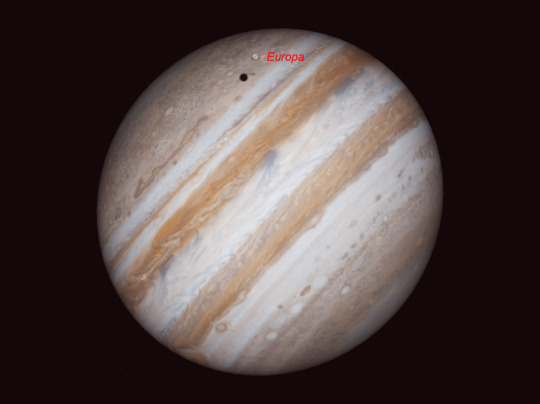
(Above: A simulated view of Jupiter for 10:20 pm EDT on May 12, when the moon Galilean Europa and its shadow will be crossing the planet’s disk.)
Astronomy Skylights for this week (from May 6th, 2018) by Chris Vaughan. (Feel free to pass this along to friends and send me your comments, questions, and suggested topics.) I post these with photos at http://astrogeoguy.tumblr.com/ where the old editions are archived. You can also follow me on Twitter as @astrogeoguy! Unless otherwise noted, all times are Eastern Time. Please click this MailChimp link to subscribe to these emails. If you are a teacher or group leader interested joining me on a guided field trip to York University’s Allan I. Carswell Observatory, or another in your area, visit www.astrogeo.ca.
If you’d like me to bring my Digital Starlab inflatable planetarium to your school or other daytime or evening event, visit DiscoveryPlantarium.com and request me. We’ll tour the Universe together!
Public Events
On Monday evenings, York University’s Allan I. Carswell Observatory runs an online star party - broadcasting views from four telescopes/cameras, answering viewer questions, and taking requests! Details are here. On Wednesday evenings after dark, they offer free public viewing through their telescopes. If it’s cloudy, the astronomers give tours and presentations. Details are here.
At 7:30 pm on Wednesday evening, May 9 the public are invited to attend the free RASC Toronto Centre Speaker’s Night Meeting at the Ontario Science Centre (Room TBD, just follow the signs). The speaker is Janakan Sivasubramanium, M.Sc. Candidate, Physics & Astronomy, York University, presenting Active Galaxies: A Hunt to Understand What Feeds These Galactic Monsters. Details are on the RASC website here.
On Friday, May 11 at 8 pm, RASC Mississauga presents Earth's Battered Moon by Sara Mazrouei, PhD Candidate in Planetary Geology, University of Toronto. Details are here.
On Friday, May 11 at 7:30 pm in the Hamilton Spectator Building, the Hamilton Amateur Astronomers will present a free workshop entitled The Nuts and Bolts of Astrophotography, geared for beginners. Everyone is welcome. Details are here.
On Friday, May 11, starting at 7 pm, the U of T AstroTour will present their planetarium show entitled Grand Tour of the Cosmos. Tickets and details are here.
Saturday, May 12 is Science Rendezvous day in Toronto, when groups will set up around the city to share the fun and fascination of science, including astronomy, with the public. Details are here. Look for University of Toronto at 100 St. George St., York University at the Markham Farmers’ Market, 132 Robinson St., and Ryerson University at Gould and Victoria Streets.
On Saturday, May 12, starting at 10:30 am, U of T Astronomy and Heritage Toronto will lead a free walking tour entitled Campus & Cosmos: Toronto’s Astronomical Heritage. Details are here.
On Saturday, May 12, starting at 8 pm, the U of T AstroTour will present their planetarium show entitled The Life and Death of Stars. Tickets and details are here.
Seeing Colour in Stars
If you missed last week’s guide to seeing a variety of bright stars, each shining with a distinctive colour of starlight, it’s here.
The Moon and Planets
Tomorrow evening, the moon will reach its Last Quarter phase, the start of the final week of its monthly trip around Earth. At last quarter, the angle between Earth, the moon, and the illuminating sun is close to 90°, so observers worldwide will see the moon’s globe half illuminated (on the side facing towards the pre-dawn sun). Last quarter moons rise after midnight and remain visible in the morning daytime sky. For the rest of the week, the moon will wane to an old crescent and shift closer to the sun. Look for its silver sliver just over the eastern horizon next weekend.
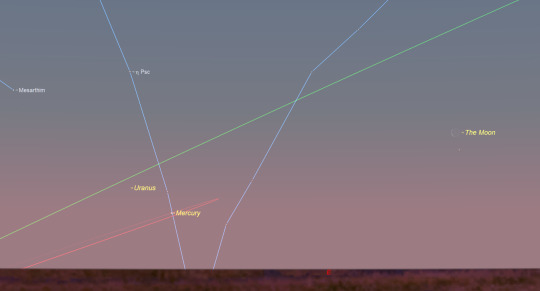
(Above: On the weekend of May 12-13, the moon will appear as a slim crescent over the pre-dawn eastern horizon, not far from elusive Mercury. The sky is shown for 5:30 am local time on Saturday.)
This week Venus will continue its domination of the western early evening sky. It will set at about 11 pm local time. Every evening, Venus’ orbital motion will lift it higher. It will end this week sitting between the stars marking the horns of Taurus (the Bull), with Zeta (ζ) Tauri (also known as天关, Tiānguān in Chinese) on the left and Elnath on the right. Elnath is also shared by the adjacent constellation Auriga (the Charioteer). Pull out your telescope and look at Venus. It’s now exhibiting a gibbous phase, appearing somewhat flattened on the top.
On Tuesday, May 8 at 9 pm EDT, Jupiter will be exactly opposite the sun in the sky, and visible all night long. On opposition night, the planet’s disk will be its brightest and largest (44.8 arc-seconds across) for the year – but it will look almost that large throughout May. The king of planets will rise in the east this week after 8 pm local time, will reach its highest elevation (about three fist diameters) above the southern horizon around 1:15 am local time, and then descend into the southwestern sky at sunrise. The bright star sitting just to the upper right of Jupiter is Libra’s (the Scales) brightest star, Zubenelgenubi. The name means “Southern Claw” because it used to be part of nearby Scorpius (the Scorpion).
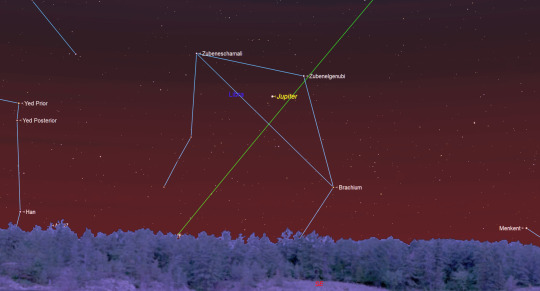
(Above: On May 8, shown here at 10 pm local time, Jupiter reaches opposition, when it is closest and brightest for the year. The stars of Libra will surround the planet all summer.)
Between Monday evening at 11 pm and Tuesday at 1 am EDT, Jupiter’s innermost moon Io and its little round black shadow will cross (or transit) Jupiter’s disk. On Saturday evening, the moon Europa and its shadow will transit between 8:38 pm to 10:54 pm EDT. On Sunday evening, the moon Ganymede and its shadow will cross near Jupiter’s north pole between 9 pm to 10:15 pm EDT (the shadow will linger until 10:45 pm. A reasonable backyard telescope will show the black shadows, but a very good telescope is needed to see the moons, too.
The Great Red Spot takes about three hours to cross Jupiter’s disk. But the planet’s 10-hour rotation period (i.e., its day) means that the spot is only observable from Earth every 2-3 nights. If you’d like to see the GRS, use a medium-sized telescope (or larger). You’ll have your best luck on evenings with steady air – when the stars are not twinkling too much. The best times to try this week are: Tuesday, May 8 at 9:31 pm and Thursday, May 10 at 11:09 pm. All times are given in Eastern Daylight Time, so adjust for your local time zone. Try to look within an hour before or after the times I’ve given.
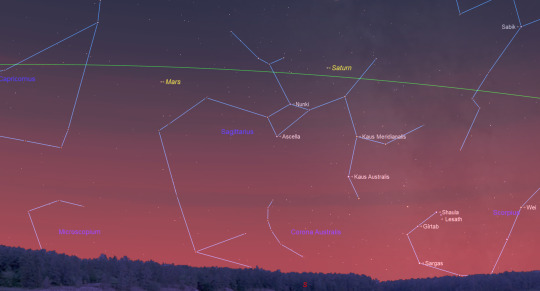
(Above: This week, Saturn and Mars rise in the middle of the night and remain in view over the southern horizon before dawn, as shown here for 5 am local time.)
At the end of this week, the ringed planet Saturn will start rising in the east just before midnight. You should be able to see its yellow-tinted point of light until about 6 am, when it will sit about 2.5 fist widths above the southern horizon. Reddish Mars will rise about 80 minutes after Saturn, which places it 1.7 fist widths to the lower left of Saturn. Mars is steadily brightening and increasing in size as the Earth’s faster orbit brings us closer to the red planet. We will pass it on the “inside track” in late July.
This week Mercury continues its trek across the eastern pre-dawn horizon. This appearance isn’t very good for observers in mid-northern latitudes. Your best time to hunt for it this week will be between 5:30 and 5:45 am local time. If you live south of the equator, however, Mercury will be very easy to see for the next week or so.
Deep Sky Delights
With the evening sky nice and dark due to the moon’s waning brightness and its late rising, this is a good week to hunt for some of the sky’s dimmer delights – globular clusters. These balls, each composed of up to a million stars, orbit the Milky Way’s centre like bees around the hive. But they are tens of thousands of light-years away from us. And they are easy to see without fancy telescopes!
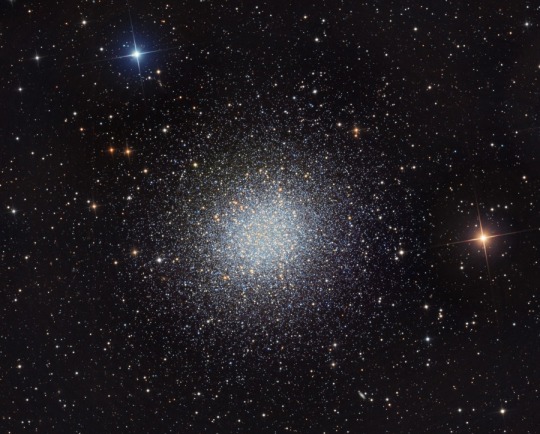
(Above: The Great Globular Cluster in Hercules, also known as Messier 13, contains perhaps a million densely packed stars. Image by Martin Pugh. NASA APOD for June 14, 2012)
The best globular clusters observable from mid-northern latitudes are now well-placed in the eastern evening sky. In early evening, use binoculars or a backyard telescope to look for 7.7 magnitude Messier 53 in Coma Berenices (Bernice’s Hair) and the slightly brighter cousin, spectacular Messier 3 in Canes Venatici (the Hunting Dogs). These globular clusters are in the sky below the Big Dipper. Messier 3 is a generous fist’s diameter to the upper right of the very bright star Arcturus, and Messier 53 is 1.4 fist diameters to the right of Arcturus.
As the evening wears on, the globulars Messier 5 in Serpens Caput (the Serpent’s Head) and Messier 92 in Hercules will rise high enough to observe. Both of those objects are also around magnitude 6.5. Messier 5 is located a bit more than two fist diameters below Arcturus. Messier 92 is 1.5 fist diameters above, and slightly to the right of, the very bright, white star Vega. For your finale, spend some time enjoying the Great Hercules Cluster, aka Messier 13. It’s on the western (right-hand) edge of the keystone-shaped body of Hercules.
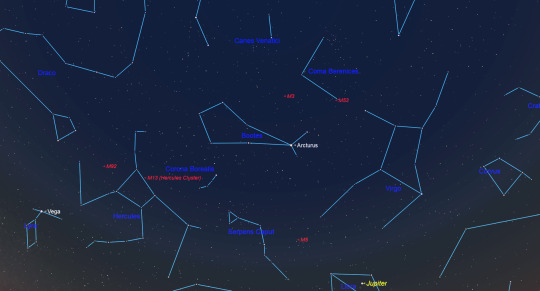
(Above: The eastern evening sky, shown here at 10 pm local time, contains a number of excellent globular clusters from Charles Messier’s famous list of deep sky objects. The handle of the Big Dipper extends downwards from top centre.)
All of these globular clusters will reach their highest altitudes after midnight. In binoculars, they’ll appear as dim fuzzy patches of light. Charles Messier, who cataloged them, thought they resembled comets – his life-long passion.
Keep looking up to enjoy the sky! I love getting questions so, if you have any, send me a note.
#Jupiter#space#astronomy#stars#planets#globular clusters#M13#Venus#Taurus#stargazing#jupiter opposition
5 notes
·
View notes